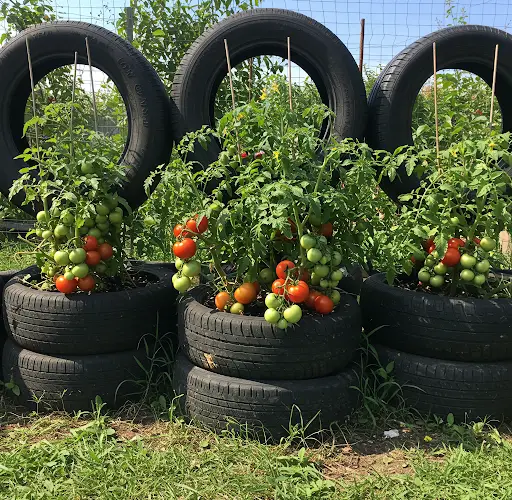Take Advantage of Super Good Tomato Growing Tires
Tomatoes are one of the most popular vegetables (technically fruits) grown in home gardens, and for good reason. They’re versatile, delicious, and relatively easy to grow. However, to get juicy, healthy tomatoes with high yield, the growing method can make all the difference. One unconventional yet highly effective method is using old tires as planting beds.
Yes—those worn-out car tires you might otherwise throw away can become powerful tools for producing healthy, high-yield tomatoes. Not only is this a space-saving and cost-effective approach, but it also promotes recycling and works wonderfully in small gardens, patios, or even balconies.
Why Grow Tomatoes in Tires?
Using tires to grow tomatoes has several practical advantages:
-
Heat Retention: The black rubber absorbs and retains heat, which helps warm the soil. This can speed up germination and boost early growth—especially useful in cooler climates or seasons.
-
Space Efficiency: Tires help you grow vertically by stacking or by using them as defined planting beds, making them ideal for small gardens or urban setups.
-
Controlled Environment: Growing in tires gives you more control over the soil quality and drainage, which is essential for healthy root development.
-
Pest Barrier: Elevating your tomatoes slightly above ground level makes it harder for ground pests to attack the plants.
Materials You’ll Need
To get started, gather the following:
-
1–2 old tires per plant (clean and chemical-free)
-
Nutrient-rich soil (a mix of compost, garden soil, and sand or coco peat)
-
Organic fertilizer (such as composted manure, fermented plant juice, or worm castings)
-
Tomato seedlings (choose disease-resistant varieties for best results)
-
Mulch (dried leaves, rice husks, or straw)
-
Support stakes or cages for the tomato vines
Choose a spot that gets at least 6–8 hours of full sunlight per day—tomatoes are sun-lovers!
Step-by-Step: Planting Tomatoes in Tires
1. Prepare the Tire Bed
Place a tire on bare soil or on a base layer of bricks for drainage. You can use a single tire for each plant or stack two tires for deeper root space. The stacked option works best for indeterminate (vining) tomato varieties that grow taller and produce longer.
2. Fill With Soil Mix
Combine garden soil with compost, coco peat, or rice husks for improved aeration. Add a handful of well-rotted organic fertilizer or bone meal to the mix. Fill the tire with the soil blend, leaving a few inches at the top.
3. Planting the Tomato Seedling
Dig a deep hole in the center of the tire and bury the tomato seedling so that at least two-thirds of the stem is underground. Tomatoes grow roots along buried stems, so this technique strengthens the plant and promotes better nutrient uptake.
Water thoroughly after planting.
4. Mulch the Soil
Apply a layer of mulch around the base to retain moisture, regulate soil temperature, and reduce weed growth.
Caring for Your Tire-Grown Tomatoes
Watering
Tomatoes need consistent watering, especially during flowering and fruiting stages. Water deeply 2–3 times a week, or more often in hot weather. Avoid wetting the leaves to prevent fungal issues.
Feeding
Fertilize every 2–3 weeks with organic liquid fertilizer, compost tea, or fermented banana peel water. Avoid high-nitrogen fertilizers, as they can encourage leafy growth at the expense of fruit production.
Support
Use a stake, cage, or trellis to support your tomato plant as it grows. Tie the plant loosely with soft string to avoid stem damage.
Pest and Disease Control
Keep an eye out for pests like whiteflies, aphids, and tomato hornworms. Use neem oil or garlic-chili spray as a natural deterrent. Also, check the undersides of leaves regularly and remove any affected parts promptly.
Good airflow between plants helps reduce fungal infections like blight or mildew. Leave enough space between tire beds to encourage circulation.
Harvest Time
Tomatoes are usually ready to harvest 60–90 days after transplanting, depending on the variety. Pick them when they’re fully colored and slightly soft to the touch. Regular harvesting encourages more fruit production.
Bonus Tips for Maximum Yield
-
Rotate crops each season—avoid planting tomatoes in the same tire bed more than once a year to prevent soil-borne diseases.
-
Use crushed eggshells in the soil to provide calcium and prevent blossom end rot.
-
Interplant with basil or marigolds to deter pests naturally.
-
Prune the lower leaves as the plant grows to improve air circulation and redirect energy to fruit production.
Final Thoughts
Growing tomatoes in tires is an excellent way to upcycle waste while producing a delicious, healthy crop at home. This method works well in both rural and urban settings and is perfect for gardeners with limited space. With the added warmth, root depth, and mobility that tires provide, your tomato plants will thrive—and reward you with a harvest to be proud of.
Whether you’re a seasoned grower or just getting your hands dirty for the first time, tire gardening might be your next favorite way to grow tomatoes.


